The Legend of Zunyi
By WU MEILING
ZUNYI City in Guizhou Province got its name from a line in the Book of History, one of the five classics of Chinese literature, written some time before the birth of Confucius (551-479 BC). The area’s history dates back even further, to the Palaeolithic ages, when it was home to the Tongzi people. Negotiating the space between the ancient Qin-Chu and Bashu civilizations, the wider Zunyi region has maintained a prominent position throughout Chinese history.
Formerly part of the territory of several ancient kingdoms, Zunyi is a mountainous city on the sloping terrain between the Sichuan Basin and the Yunnan-Guizhou Plateau. In the early Tang Dynasty (618-907) a prefecture known as Bozhou was founded here, but was subsequently wiped out in a war in 1601. The region was rebranded as “Zunyi” 400 years ago, and the name has stuck.
Warring Past
Hailongtun, or Ocean Dragon’s Castle, is a fortress on the cliffs of Longyan Mountain in northwest Zunyi. Built in 1257 during the Southern Song Dynasty by local magistrate Yang Wen, the 750-year-old construction defended the region against Mongolian forces, and continued to provide protection in the following Yuan (1271-1368) and Ming (1368-1644) dynasties. More than just a military garrison, the complex is in a sense a miniature ancient city, with a palace, ancestral temples, living quarters, a warehouse and a clinic. It was locally designed and built through collaboration between architects of diverse ethnic backgrounds, including Han, Miao, Gelao and Tujia, and hence stands out for its distinctive blending of architectural features.
The story of the rise and fall of the fortress is intertwined with that of the Yang family, which ruled the region for centuries. In the late Tang Dynasty Bozhou was overtaken by the neighboring Nanzhao regime, and Tang forces led by Yang Duan were sent in to win it back. After his victory, Yang Duan remained in the area to govern, marking the beginning of his family’s prominence. His son inherited his title.
In 1257 Mongolian forces approached Bozhou after conquering the neighboring Dali Kingdom. Incumbent governor Yang Wen applied to the Southern Song court to build a defense command, and got speedy approval. Hailongtun was thus erected.
In 1573 Yang Yinglong inherited the position of Bozhou governor from his father. The Ming Dynasty at the time had a lax policy towards regional officials in the southwestern regions, which it regarded as fringe ethnic minority backwaters. As long as regions sent the required tribute to the imperial court, local rulers were essentially given free rein to do as they pleased. With its fertile lands and plentiful harvest, Bozhou was coveted by warlords in both Sichuan and Guizhou. Backed by a sizable army, Yang Yinglong led an extravagant and kingly lifestyle and ruled with an iron fist. When he killed his wife following an altercation over his concubine, Guizhou officials reported him to the central authority, charging him with attempts to rebel, among other crimes. The Song emperor sent an army of 240,000 that besieged Hailongtun. After a bloody battle that lasted 114 days the imperial forces broke through Hailongtun’s rear fortifications. Yang Yinglong locked himself and two concubines in a room and set it alight. The imperial forces staged a massacre, decapitating more than 20,000 locals and ending the 725-year rule of the Yang family in the region.
Hailongtun was designated a provincial-level historical site in 1992, and was put under state protection in 2001. Work is now underway to put it on the world cultural heritage list.
|
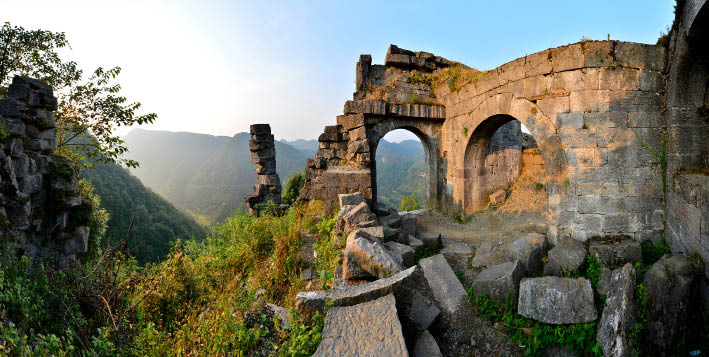 |
| A ruined section of Hailongtun fortress. |
Revolutionary Fame
In today’s era, Zunyi gained fame as venue of the Zunyi Conference, an important meeting during the Communist Party’s epoch-making Long March. At the meeting, held in 1935, the Central Committee of the Communist Party of China rectified its previous errors in policy making and agreed on a new strategic approach that would eventually win victory for the Red Army. The conference room still stands, and today a plaque featuring hand-written characters by the late Chairman Mao Zedong greets visitors.
According to the official history of the Communist Party of China, the Zunyi Conference was a pivotal moment in the development of the Red Army and for the party itself. During the meeting, the extreme “Leftist thought” of Wang Ming, the previous party leader, was rejected. The move ended up saving both the Red Army and the party from demise.
On the slopes of Xiaolong Mountain lies the Cemetery for Fallen Red Army Soldiers. Covered by lush green vegetation, the cemetery was built to face the Xiangjiang River. In front of the cemetery stands a monument featuring large golden handwritten characters by late state leader Deng Xiaoping, which read, “Red Army Martyrs Are Immortal.” Right behind the monument lies the tomb of Deng Ping, chief of staff of the Third Red Army Corps. Seventy-seven soldiers are buried next to him, the youngest just 20 years old.
Also buried in the cemetery was a young Red Army medic named Long Siquan. In January 1935, a serious epidemic typhoid fever devastated the area just as the Red Army was passing through. Long Siquan left his fellow soldiers to help the villagers by providing them with medical assistance. He never returned to the ranks – he was found by enemy troops and killed. His tomb was erected by the villagers, and generation after generation of locals have cleaned his tomb every spring to cherish the memory of the kind-hearted medic.
Zunyi is a historical place, but the events of the past come alive in the countless moving tales of revolutionary valor that survive to this day. One such tale is, in fact, a love story. When the Red Army arrived at Zunyi in January 1935, a female soldier named Wang Quanyuan and her boyfriend Wang Shoudao, both working with the security department, planned to marry. According to tradition in their home province of Jiangxi, the bride and groom were to exchange gifts on their wedding night. Wang Shoudao’s gift to his bride was a pistol and eight bullets he had just won in battle. Wang Quanyuan, however, failed to live up to tradition, which dictated she must gift her soon-to-be husband with a pair of cloth shoes that she herself had made. She had found neither the time nor the materials necessary to make the shoes during the war. She promised to do so after the war had ended and supplies were at hand. In the end, she kept her word, but Wang Shoudao had to wait half a century for his new shoes.
After their wedding, the couple parted and did not meet again till June of that year, and for only one day. They were separated after being assigned to different troops. Wang Quanyuan was eventually promoted to the rank of regimental commander, leading 1,300 female soldiers. She fought bravely in many battles before being wounded and captured. She spent a number of years being tortured for information in prison, before finally escaping and fleeing to safety. She had lost contact with the Red Army and the Communist Party, however, and lived a solitary existence in the countryside for several decades.
Wang Quanyuan was eventually “found” by veterans’ organizations in the summer of 1982, aged 76. She was summoned to Beijing, where the authorities renewed her party membership. Just as she was about to go home, she received startling news: Wang Shoudao, her one-time husband and then vice chairman of the National Committee of the Chinese People’s Political Consultative Conference, was coming to visit her. The meeting after half a century by two senior revolutionaries was a sacred moment. The two sat, speechless, holding hands as they wept.
Ten years after the reunion, Wang Quanyuan came to Beijing again, this time to visit Wang Shoudao, who lay sick in hospital. Although she hadn’t brought food or drink, she did come prepared with something better: a pair of cloth shoes. She’d made them herself, just as she promised, though with considerable difficulty considering her poor eyesight and shaky hands.
On receiving the gift, Wang Shoudao said to his one-time sweetheart: “I am so happy you have finally come good on your wedding promise after such a long time.”
|
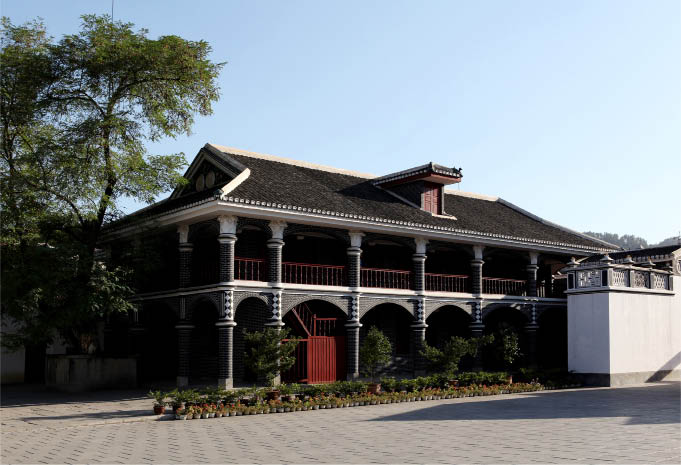 |
| Site of the Zunyi Conference. |
Shatan School
Shatan Village, located in Xinzhou Town of Zunyi City, is 47 kilometers from the modern downtown area. The village takes its name from a shoal on the Le’an River, though colloquially it is referred to as Qinzhou, as it is laid out in a way that supposedly resembles the qin, an ancient Chinese string instrument. The greater Shatan area contains waterways, farmers’ fields, bamboo forests, thousand-year-old cypress trees and a number of ancient temples. The natural bounty has produced many a man of note in Chinese history, including Zheng Zhen, Mo Youzhi and Li Shuchang. The combined cultural influence of these men of letters is referred to as the Shatan School.
Guizhou Province is a land of culture, and Shatan especially so. The Shatan School finds its genesis in the Eastern Han Dynasty (25-220) with the noted educator and calligrapher Yin Zhen. With his follower (some say equal) Li Xun, Yin Zhen championed local culture and regional-based philosophy.
Entering our era, Zhang Shizhao kept the Shatan School of philosophical thinking alive. Zhang in his writing was keen to stress the continuity of the school, and champions the legacies of the aforementioned Zheng Zhen and Mo Youzhi, who co-wrote Annals of Zunyi Prefecture, a document highly praised for its acuity by Liang Qichao, a renowned reformist and philosopher of the late Qing Dynasty. The work has since been favorably compared with many of China’s great histories.
Mo Youzhi is depicted in the annals as a well-read man of high moral integrity. He is said to have refused high posts in the royal court in order to continue with his studies. Zeng Guofan, a high-ranking official at the time, attended Mo’s funeral and penned an elegant couplet in his honor.
In the modern area, Li Shuchang is perhaps Shatan’s most notable alumnus. He was the first Guizhou native to serve in China’s diplomatic corps overseas, and served as a counselor to Chinese embassies in Europe. He interacted extensively with officials from the U.K., France, Germany, Spain, Belgium, Italy, Austria and Sweden, and wrote a book about his experiences. His efforts have brought the European and Chinese peoples closer together.
|
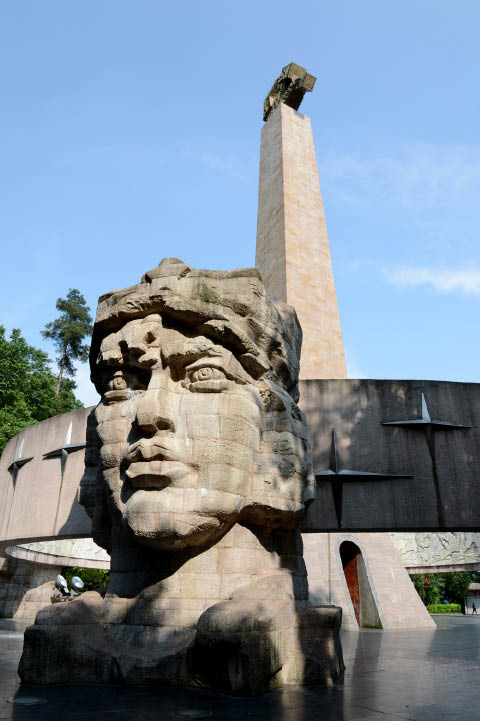 |
| The cemetary for fallen Red Army soldiers in Zunyi. |
Chishui Waterfall
Shatan doesn’t have a monopoly on Zunyi’s natural spectacle. Mountains, rivers, hot springs and caves are dotted throughout the city’s broad territory. One site, Danxia, is listed by UNESCO as a world heritage site. “Danxia” is the name given to local landscapes developed on continental red terrigenous sedimentary beds influenced by endogenous forces (including uplift) and exogenous forces (including weathering and erosion). The scientific explanation doesn’t do the area justice – Danxia scenery is truly awe-inspiring.
Zunyi’s potential for nature tourism, yet to be tapped, deserves to be mentioned alongside well-worn sites like the Three Gorges and Jiuzhaigou. Among Zunyi’s sites definitely worth a visit are the Chishui Waterfall, the Chahai tea-growing region, the river valleys of Wujiang, Kuankuoshui and Dashahe, the lake area of Qingxi, Phoenix Mountain, Bamboo Sea and a number of national and provincial forest parks. Danxia should be on every nature tourist’s list. Another highlight is the Shuanghe karst cave, formed naturally over millions of years by the dissolution of soluble bedrock.
The Chishui Waterfall, also known as Shizhangdong, is located 39 kilometers from Chishui City on the middle reaches of the Fengxi River. Alongside Huangguoshu, it is one of Guizhou’s two most famous waterfalls. Measuring 76 meters in vertical distance and 80 meters wide, the Chuishui Waterfall is eight meters taller than Huangguoshu’s, and one meter narrower.
Owing to its remote locations, the Chishui Waterfall was a secret until relatively recently. It was officially “discovered” during the Yongle Period of the Ming Dynasty (1368-1644), when an official stumbled across it. The official was responsible for transporting Nanmu, a special kind of local wooded plant, to the royal court. But he was so amazed by what he found that he found an excuse to remain in Chishui. He ended up settling down there, and stayed for 25 years. Subsequently, a Qing Dynasty historian wrote a poem as a record of the official’s time near his beloved waterfall.
The poem did not make the place well known, however. Fame came to it in the 1980s when plans were discussed for a local hydropower project. CCTV broadcast images of the waterfall to the nation for the first time on July 19, 1986, and soon after, tourists started to arrive in numbers.
There is much fine scenery around the Chishui Waterfall, including centuries-old pathways, karst stones, the Xiangxi Lake, tea fields and stalagmites. The spot is also home to much fauna, including the clouded leopard, milu deer and macaques.
Chishui is locally known as the city of a thousand waterfalls. Though this is likely a bit of an exaggeration, there are certainly a lot of them. Danxia Watersprings, the Sidonggou Waterfalls, the Yanziyan Waterfall… all have their own stories, legends and mysteries.
|
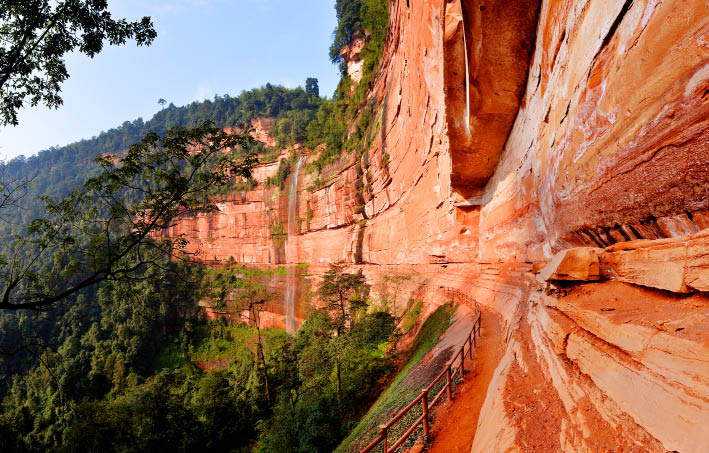 |
| The red rock landform in Chishui. |
Jurassic Connection
Chishui’s National Nature Reserve is the world’s only protected zone for the ancient Spinulose Tree Fern. The trees are indigenous to the region, and the reserve is home to 40,000 of them.
Standing in front of these trees, I was thinking about news of a dinosaur fossil discovery in nearby Yunnan Province. These trees have been around as long as that fossil, I thought. Perhaps the dinosaur – I forget which kind it was – even snacked on Spinulose leaves – they certainly looked big enough to make a meal for the now-extinct vertebrates.
The dinosaurs and the Spinulose Tree Fern once co-existed in the Jurassic Period of the Mesozoic Era from roughly 201 to 145 million years ago. The tree is now an enduring symbol of that time. Few of the species survived the climatic and geological vicissitudes that led to the current era. In China, the species can be found – in sparse numbers – in southern provinces of Yunnan, Sichuan and Fujian. In Guizhou Province, however, their numbers are far greater. Many have tried introducing the trees, concentrated in Zunyi, into locales further north, but their attempts have generally been unsuccessful. Obviously there’s something special about Zunyi soil.
The trees are a monument to longevity. They still stand tall, while the majestic dinosaurs are long gone. Their biology provides scientists today with interesting insights into prehistoric times and evolutionary processes. The Chinese records on the trees dating from the 18th century show that 300 years ago locals were just as fascinated with the trees as scientists are today.
Spinulose Tree Fern in the protection zone can reach eight to nine meters in height. Average height is between four and six meters, and they grow less than one centimeter per year. The species has changed very little over 200 million years – tree trunks still stand tall and straight, and the umbrella-like branches that unfold at the top still features split leaves, which remind one of bird feathers.
|
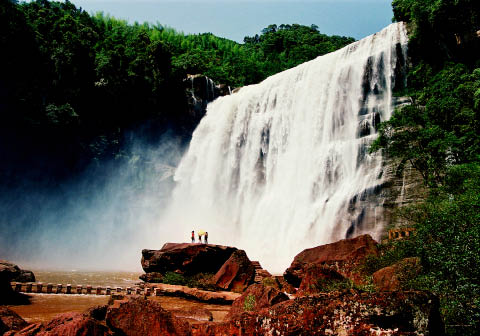 |
| The Shizhangdong Waterfall. |
The Qingxi Lake
The Qingxi Lake is an oddity – 50 kilometers long, yet less than 100 meters wide. Located in Suiyang County of Zunyi City, it is beautiful – though it was actually formed by man-made processes. At Qingxi, man has made beauty comparable to nature’s own hand – surely a rare occurrence.
Karst landforms, caves, and mountains follow the contours of the lake. It’s almost like it should always have been here, only Mother Nature forgot to add water. Tourists can hire a boat and float along the calm waters to admire the surrounding scenery.
The most beautiful time to visit the Qingxi Lake is after a rainstorm. Heavy downpour brings out an alluring mist in the water; rainbows arch out to frame nearby cliffs. The air is fresh and clean, and at night, cloudless skies fill with celestial splendor.
Jiudaomen is the wild side of the Qingxi Lake zone. The area features 13 enormous rock pillars that rise out of the flat earth. They are dotted with pines and cypress trees and rather resemble the “floating mountains” in James Cameron’s Avatar.
One excellent section on which to boat is midway up the lake in an 11.8-kilometer long, 20-meter wide canyon. Cliffs rise up on both sides to between 100 and 150 meters high. The slow cruise takes two to three hours. The water is clear in some parts, and ruffled in others. Nearby is a hotel complex should you wish to escape the city and stay for the night.
|
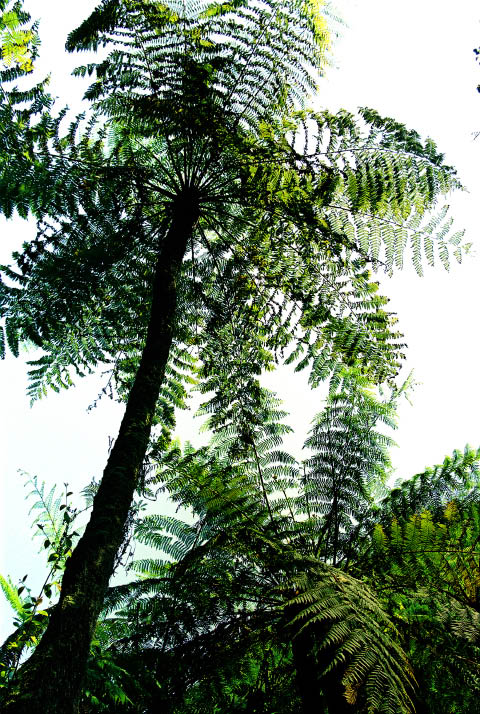 |
| A Spinulose Tree Fern nature reserve in Chishui. |
Cave Culture
The Shuanghe karst cave is enormous. So enormous, in fact, that domestic and international experts are still exploring it. They know it is at least 145 kilometers long, and contains three levels with eight large cave structures, 118 smaller ones, four subterranean rivers and 23 access routes. It is China’s longest and biggest cave group.
Of the explored areas, the evocative scenery has resulted in creative naming – Gypsum Cave, Water Curtain Cave, Lotus Cave, Sweet-scented Osmanthus Cave, Mountain King Cave, Cedar Tree Cave and others attest to some vivid imaginations on behalf of the first explorers.
The Sweet-scented Osmanthus Cave is a particular highlight. It has 5,000 square meters of helictite along its length of 500 meters – Asia’s largest helictite spectacle. The silvery formations create a wonderland as amazing as your imagination can conjure.
“Cave culture” has long been a facet of Guizhou society. The caves have played a part in human lives as early as 200,000 years ago when the cave-dwelling Tongzi people were discovered through to the modern record. In the Ming Dynasty philosopher Wang Yangming held lessons in the caves. During the war against Japanese aggression, Generals Zhang Xueliang and Yang Hucheng were exiled to the caves by Chiang Kai-shek for suggesting a united front with the Communists against the invaders. During the subsequent civil war, crop harvests were stored in the cool caves to ensure a stable food supply. The history continues.
|
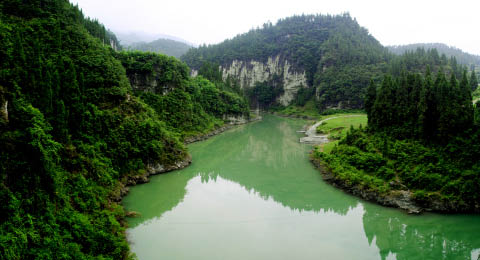 |
| Kuankuoshui Nature Reserve. |
Local Liquor
While in Zunyi, tasting the local tea is a must. When you’re done with the tea, you can move onto the many varities of local liquor. There are so many you probably won’t get through them all. One you must try is Moutai, perhaps China’s most famous – and certainly most expensive – drop. There are more than 100 registered liquor distillers in the Zunyi area, but only ten of them are recognized as top-tier.
The pure water of the Chishui River from its source in Chuxiong, Yunnan Province is used to potent effect in Zunyi’s liquor industry. The Chishui is a tributary of the Yangtze, the longest river in Asia and the third-longest in the world. The Chishui is also known as Meijiu, or “Fine Liquor,” River, and its water has been used in making alcohol since time immemorial. “Chishui” itself means “red water,” a name that comes from rain water washing over the river’s muddy banks, which are reddish in color.
The Moutai liquor brand has a long history. In 1915 it entered the world stage when it won a silver medal at EXPOCOMER in Panama. The drink is incredibly popular in China to this day, and the best vintages fetch high prices.
Chinese liquor is growing in popularity worldwide. Throughout the country’s history, liquor has been a romantic symbol, much like wine in Europe. Poets have imbibed it and extolled its wonders. It is said Li Bai of the Tang Dynasty couldn’t pick up his brush without a drop of liquor first. The Preface to the Orchid Pavillion Collection, one of China’s early masterworks, is said to have been written entirely under the influence. Liquor is part of China’s heritage, and the best liquor comes from Zunyi. After a day spent marveling at the area’s Jurassic tree ferns, humbling cave complexes and tranquil lakes, kick back in your hotel and pour yourself a glass.

A Kweichou Moutai Group packing line. Photos by Hu Zhigang

